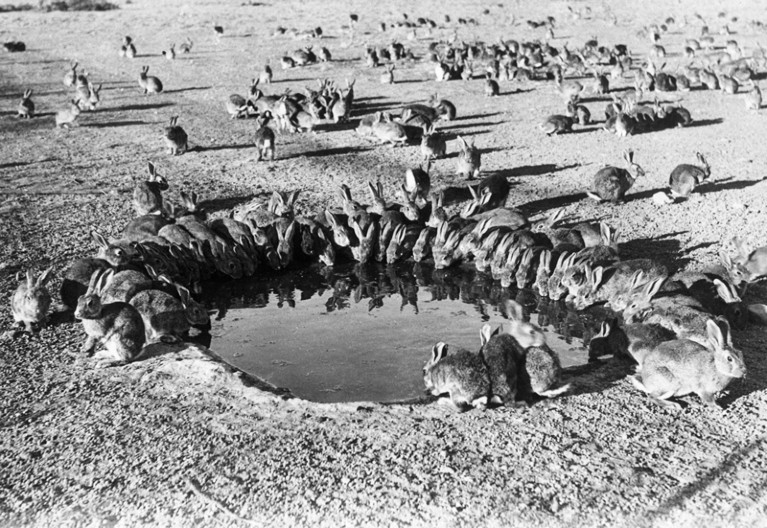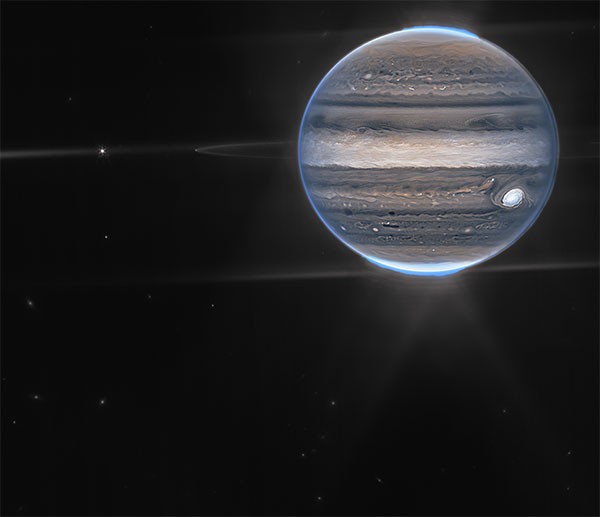Hello Nature readers, would you like to get this Briefing in your inbox free every day? Sign up here

Rabbits have had a disastrous impact on Australian agriculture and native plants.Credit: Bettman/Getty
How a handful of bunnies invaded Australia
Australia’s invasive rabbit population probably originated from a shipment of two dozen wild English rabbits that arrived near Melbourne on Christmas Day 1859. A genomic analysis found that Oryctolagus cuniculus’s wild ancestry probably gave it an advantage over previous arrivals. “That single event triggered this enormous catastrophe, ecologically and economically, in Australia,” says evolutionary geneticist and study co-author Francis Jiggins.
‘He has saved countless lives’
Anthony Fauci, who has been the top infectious-diseases adviser in the United States for almost 40 years, will leave his leadership roles in December. From the AIDS epidemic to the COVID-19 pandemic, the iconic medical chief has advised seven US presidents on numerous outbreaks. “Dr Fauci is the most dedicated public servant I have ever known,” says former US National Institutes of Health director Francis Collins. “His contributions have saved countless lives from HIV/AIDS, Ebola and SARS-CoV-2, and will stand as profoundly significant gifts to humanity.” But don’t call it retirement, says the 81-year-old Fauci. “I plan to pursue the next phase of my career while I still have so much energy and passion for my field.”
Zaps improve older people’s memory
Cognitive neuroscientists have demonstrated that stimulating the brains of adults aged over 65 with weak electrical currents repeatedly over several days led to memory improvements that persisted for up to a month. They used transcranial alternating current stimulation, a non-invasive method involving electrodes placed on the surface of the scalp. Zapping the dorsolateral prefrontal cortex — a region near the front of the brain — with high-frequency electrical currents improved long-term memory. Stimulating the inferior parietal lobe, which is further back in the brain, with low-frequency electrical currents boosted working memory.
Reference: Nature Neuroscience paper
Trees are sweeping into the Arctic tundra
The Arctic treeline is moving at a worrying pace. A study has found that white spruce (Picea glauca) trees are spreading north in the Alaskan tundra at more than four kilometres per decade — faster than any conifer treeline ever measured. “When you see trees growing, you know that the climate has really shifted,” says ecologist and co-author Roman Dial. “It's not like five years of weather, or ten years of weather. It's 30 years of climate that’s established new trees in new places.” The spruce trees, in turn, contribute to further warming because they reflect less sunlight than the snow that used to cover the same land.
Features & opinion
How to build ‘green, cool, beautiful’ cities
Civil engineer Briony Rogers works on projects that address the tension that exists between cities and water: they are commonly located next to important water sources, such as rivers, but many have been developed in ways that dislocate them from their water environments, such as by draining swampland. In Australia, known for its droughts and floods, Rogers is investigating not only how to insulate cities against water shocks, but also how to use water to make them more liveable and healthy.
This article is part of Nature Spotlight: Smart cities, an editorially independent supplement.
Image of the week

This image of Jupiter was taken with the James Webb Space Telescope’s Near-Infrared Camera. The camera captures infrared light, which here has been mapped into the visible spectrum. The image shows Jupiter’s aurora gleaming over its poles, its faint rings and its two tiny moons: Amalthea is the bright pinpoint of light to the left of the planet, and Adrastea is very faint halfway between the two, at the edge of a ring. The fuzzy spots in the lower background are probably galaxies photobombing the Jovian view. The image was produced by Judy Schmidt, who works on telescope data as a hobby, in collaboration with planetary scientist Ricardo Hueso. The Webb image is shockingly good, says planetary astronomer Imke de Pater. “It’s really remarkable that we can see details on Jupiter together with its rings, tiny satellites, and even galaxies in one image.” (NASA James Webb Space Telescope blog | 5 min read) Credit: NASA, ESA, Jupiter ERS Team; image processing by Ricardo Hueso (UPV/EHU) and Judy Schmidt
